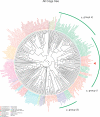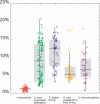Genome analysis of Minibacterium massiliensis highlights the convergent evolution of water-living bacteria
- PMID: 17722982
- PMCID: PMC1950954
- DOI: 10.1371/journal.pgen.0030138
Genome analysis of Minibacterium massiliensis highlights the convergent evolution of water-living bacteria
Abstract
Filtration usually eliminates water-living bacteria. Here, we report on the complete genome sequence of Minibacterium massiliensis, a beta-proteobacteria that was recovered from 0.22-mum filtered water used for patients in the hospital. The unexpectedly large 4,110,251-nucleotide genome sequence of M. massiliensis was determined using the traditional shotgun sequencing approach. Bioinformatic analyses shows that the M. massiliensis genome sequence illustrates characteristic features of water-living bacteria, including overrepresentation of genes encoding transporters and transcription regulators. Phylogenomic analysis based on the gene content of available bacterial genome sequences displays a congruent evolution of water-living bacteria from various taxonomic origins, principally for genes involved in energy production and conversion, cell division, chromosome partitioning, and lipid metabolism. This phylogenomic clustering partially results from lateral gene transfer, which appears to be more frequent in water than in other environments. The M. massiliensis genome analyses strongly suggest that water-living bacteria are a common source for genes involved in heavy-metal resistance, antibiotics resistance, and virulence factors.
Conflict of interest statement
Competing interests. The authors have declared that no competing interests exist.
Figures






Similar articles
-
Babela massiliensis, a representative of a widespread bacterial phylum with unusual adaptations to parasitism in amoebae.Biol Direct. 2015 Mar 31;10:13. doi: 10.1186/s13062-015-0043-z. Biol Direct. 2015. PMID: 25884386 Free PMC article.
-
The genome sequence of an anaerobic aromatic-degrading denitrifying bacterium, strain EbN1.Arch Microbiol. 2005 Jan;183(1):27-36. doi: 10.1007/s00203-004-0742-9. Epub 2004 Nov 13. Arch Microbiol. 2005. PMID: 15551059
-
Complete genomes of freshwater sulfur oxidizers Sulfuricella denitrificans skB26 and Sulfuritalea hydrogenivorans sk43H: genetic insights into the sulfur oxidation pathway of betaproteobacteria.Syst Appl Microbiol. 2014 Sep;37(6):387-95. doi: 10.1016/j.syapm.2014.05.010. Epub 2014 Jun 24. Syst Appl Microbiol. 2014. PMID: 25017294
-
Integrons: agents of bacterial evolution.Nat Rev Microbiol. 2006 Aug;4(8):608-20. doi: 10.1038/nrmicro1462. Nat Rev Microbiol. 2006. PMID: 16845431 Review.
-
Cupriavidus metallidurans: evolution of a metal-resistant bacterium.Antonie Van Leeuwenhoek. 2009 Aug;96(2):115-39. doi: 10.1007/s10482-008-9284-5. Epub 2008 Oct 1. Antonie Van Leeuwenhoek. 2009. PMID: 18830684 Review.
Cited by
-
The genome of Bacillus coahuilensis reveals adaptations essential for survival in the relic of an ancient marine environment.Proc Natl Acad Sci U S A. 2008 Apr 15;105(15):5803-8. doi: 10.1073/pnas.0800981105. Epub 2008 Apr 11. Proc Natl Acad Sci U S A. 2008. PMID: 18408155 Free PMC article.
-
Dark matter in a deep-sea vent and in human mouth.Environ Microbiol. 2007 Oct;9(10):2385-91. doi: 10.1111/j.1462-2920.2007.01434.x. Environ Microbiol. 2007. PMID: 17803764 Free PMC article. No abstract available.
-
Comparative metagenomics of two microbial mats at Cuatro Ciénegas Basin II: community structure and composition in oligotrophic environments.Astrobiology. 2012 Jul;12(7):659-73. doi: 10.1089/ast.2011.0724. Astrobiology. 2012. PMID: 22920516 Free PMC article.
-
The complete genome sequence of Cupriavidus metallidurans strain CH34, a master survivalist in harsh and anthropogenic environments.PLoS One. 2010 May 5;5(5):e10433. doi: 10.1371/journal.pone.0010433. PLoS One. 2010. PMID: 20463976 Free PMC article.
-
Draft genome of Gemmata massiliana sp. nov, a water-borne Planctomycetes species exhibiting two variants.Stand Genomic Sci. 2015 Dec 7;10:120. doi: 10.1186/s40793-015-0103-0. eCollection 2015. Stand Genomic Sci. 2015. PMID: 26649148 Free PMC article.
References
-
- Poindexter JS. Oligotrophy - fast and famine existence. Adv Microb Ecol. 1981;5:63–89.
-
- Iizuka T, Yamanaka S, Nishiyama T, Hiraishi A. Isolation and phylogenetic analysis of aerobic copiotrophic ultramicrobacteria from urban soil. J Gen Appl Microbiol. 1998;44:75–84. - PubMed
Publication types
MeSH terms
Substances
Associated data
- Actions
LinkOut - more resources
Full Text Sources
Molecular Biology Databases

